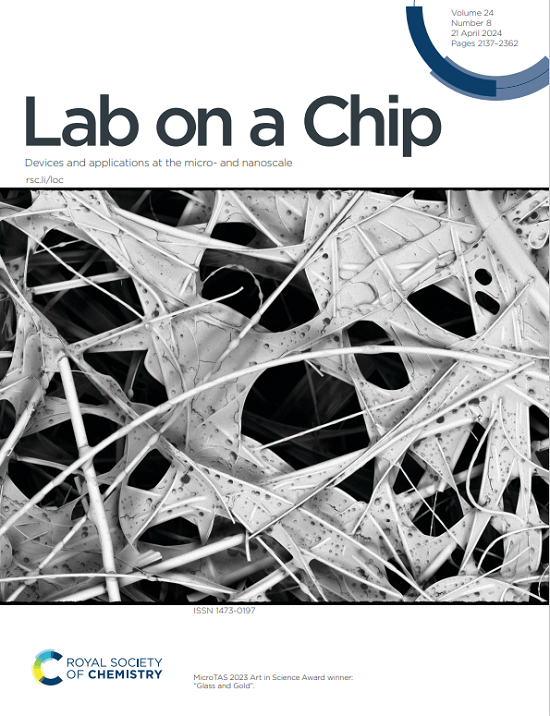Inverse 3D ‘lab-on-a-chip’ polymeric microfilms for selective capture of circulating tumor cells from patients’ blood
IF 5.4
2区 工程技术
Q1 BIOCHEMICAL RESEARCH METHODS
引用次数: 0
Abstract
Engineering inverse 3D polymeric microfilms with controlled spatial hierarchy is highly challenging and important at the crossroads of biology and material science due to its potential in enhancing selective cell surface interactions such as in cell adhesion and growth. Protein-modified inverse 3D polymeric microfilms, could thus similarly promote selective cell capture and adhesion. We report the fabrication of inverse 3D polymeric microfilms using composite polymeric-bioligand conjugated films for enhanced capture of circulating tumor cells (CTCs) from cancer patients’ blood. The microfilms were designed using functionalized poly(lactic acid) (PLA) and poly(lactic-co-glycolic acid) (PLGA), mediated with ligand transferrin. Protein immobilization on the films was achieved by conjugating transferrin (Tf), collagen (Co), and bovine serum albumin (BSA) for promoting cellular adhesion and capture. The films were evaluated using scanning electron microscopy (SEM), infrared spectroscopy (ATR-IR) and contact angle (θ) measurements, and demonstrated micro-pores ranging from 18-26 µm. Confocal laser scanning microscopy (CLSM) revealed enhanced cell attachment on the polymeric-blend microfilms evidencing enhanced cell adhesion, capture, and further the ability to proliferate in the 3D space. The inverse 3D polymeric microfilms demonstrated an 80% cell capture efficiency using cultured cancer cells. In a clinical utility, the CTC capturing efficiency was comparable with OncoDiscover® CTC enumeration technology. The inverse 3D polymeric microfilms present a novel ‘lab-on-a-chip’ platform to enable enumeration of CTCs for monitoring minimal residual disease (MRD), progress of metastasis, response to treatment, and finally in early detection of relapse.逆向3D“芯片实验室”聚合微膜用于选择性捕获患者血液中的循环肿瘤细胞
由于具有增强细胞粘附和生长等选择性细胞表面相互作用的潜力,具有控制空间层次的工程逆3D聚合物微膜在生物学和材料科学的十字路口具有高度挑战性和重要性。因此,蛋白质修饰的逆3D聚合物微膜可以类似地促进选择性细胞捕获和粘附。我们报道了利用复合聚合物-生物配体共轭膜制备逆3D聚合物微膜,以增强对癌症患者血液中循环肿瘤细胞(ctc)的捕获。微膜设计采用功能化聚乳酸(PLA)和聚乳酸-羟基乙酸(PLGA),配体转铁蛋白介导。通过偶联转铁蛋白(Tf)、胶原蛋白(Co)和牛血清白蛋白(BSA)在膜上实现蛋白固定,以促进细胞粘附和捕获。通过扫描电镜(SEM)、红外光谱(ATR-IR)和接触角(θ)测量对膜进行了评价,发现微孔范围为18-26µm。共聚焦激光扫描显微镜(CLSM)显示,聚合物共混微膜上的细胞附着增强,证明了细胞粘附、捕获和进一步在3D空间中增殖的能力增强。倒置3D聚合物微膜在培养癌细胞上的细胞捕获效率为80%。在临床应用中,CTC捕获效率与OncoDiscover®CTC枚举技术相当。逆3D聚合物微膜提供了一种新型的“芯片实验室”平台,可以对ctc进行计数,以监测微小残留疾病(MRD)、转移进展、治疗反应,并最终早期发现复发。
本文章由计算机程序翻译,如有差异,请以英文原文为准。
求助全文
约1分钟内获得全文
求助全文
来源期刊

Lab on a Chip
工程技术-化学综合
CiteScore
11.10
自引率
8.20%
发文量
434
审稿时长
2.6 months
期刊介绍:
Lab on a Chip is the premiere journal that publishes cutting-edge research in the field of miniaturization. By their very nature, microfluidic/nanofluidic/miniaturized systems are at the intersection of disciplines, spanning fundamental research to high-end application, which is reflected by the broad readership of the journal. Lab on a Chip publishes two types of papers on original research: full-length research papers and communications. Papers should demonstrate innovations, which can come from technical advancements or applications addressing pressing needs in globally important areas. The journal also publishes Comments, Reviews, and Perspectives.
 求助内容:
求助内容: 应助结果提醒方式:
应助结果提醒方式:


